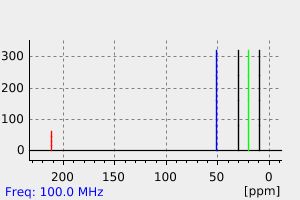meso-3,4-diethyl-hexane-2,5-dione | 34506-19-9
中文名称
——
中文别名
——
英文名称
meso-3,4-diethyl-hexane-2,5-dione
英文别名
(3S,4R)-3,4-Diethylhexane-2,5-dione;(3R,4S)-3,4-diethylhexane-2,5-dione
CAS
34506-19-9
化学式
C10H18O2
mdl
——
分子量
170.252
InChiKey
WTQCNKKZKCLSLA-AOOOYVTPSA-N
BEILSTEIN
——
EINECS
——
-
物化性质
-
计算性质
-
ADMET
-
安全信息
-
SDS
-
制备方法与用途
-
上下游信息
-
文献信息
-
表征谱图
-
同类化合物
-
相关功能分类
-
相关结构分类
物化性质
-
熔点:40-42 °C
-
沸点:42-45 °C(Press: 0.05 Torr)
-
密度:0.902±0.06 g/cm3(Predicted)
计算性质
-
辛醇/水分配系数(LogP):1.4
-
重原子数:12
-
可旋转键数:5
-
环数:0.0
-
sp3杂化的碳原子比例:0.8
-
拓扑面积:34.1
-
氢给体数:0
-
氢受体数:2
SDS
反应信息
-
作为反应物:描述:参考文献:名称:Intermediates in the Paal-Knorr Synthesis of Furans摘要:New experimental evidence for the mechanism of the Paal-Knorr reaction involving the acid-catalyzed cyclization of a 1,4-diketone to form a furan is reported. In aqueous or alcoholic solutions containing hydrochloric acid and in chloroform containing boron trifluoride-etherate d,l- and meso-3,4-diethyl-2,5-hexanediones (2r and 2m) cyclize at unequal rates; the stereochemical configuration of the unchanged done is preserved during the reaction. This disagrees with the commonly accepted mechanism involving the ring closure of the rapidly formed monoenol (11b) followed by loss of water. A pathway involving the rapid protonation of one of the carbonyls followed by the electrophilic attack on the protonated carbonyl by the enol being formed at the other carbonyl group (10c) is proposed to account for the difference in reaction rates between the diastereomers of 3,4-disubstituted 2,5-hexanediones (1-3). The following results also seem to support the intermediacy of 10c. The presence of two isopropyl groups in 3,4-diisopropyl-2,5-hexanedione (3) considerably reduces the rate of cyclization, The catalytic constants k(H)(+) for the cyclization of 2r and 2m are larger than the constants for enolization of methyl ketones. The diastereomers of 2,3-dimethyl-and 2,3-diethyl-1,4-diphenyl-1,4-butanediones (4 and 5), which could enolize only toward the center of the molecule, also react at different rates. The d,l and meso dideuterio analogs (d(2)-4r and d(2)-4m) exhibit a primary isotope effect during cyclization. The order of cyclization of 1,4-diphenyl-1,4-butanedione (6) and its analogs (7-9) reveals that the presence of electron-donating groups facilitate the reaction.DOI:10.1021/jo00107a006
-
作为产物:描述:参考文献:名称:Electrochemical synthesis of compounds of general formula (R1CH2·CR2·Y)2摘要:在具有CH2=CR2·Y型底物(Y = CHO、COMe、CO2Et和CN)存在下,有机酸R1CO2H的阳极氧化反应以良好的产率生成通式为(R1·CH2·CR2·Y)2的二聚产物。DOI:10.1039/c29710001369
文献信息
-
Stereoisomer effects on the Paal-Knorr synthesis of pyrroles作者:Gyongyi Szakal-Quin、Doyle G. Graham、David S. Millington、David A. Maltby、Andrew T. McPhailDOI:10.1021/jo00355a010日期:1986.3
-
Intermediates in the Paal-Knorr synthesis of pyrroles作者:Venkataraman Amarnath、Douglas C. Anthony、Kalyani Amarnath、William M. Valentine、Lawrence A. Wetterau、Doyle G. GrahamDOI:10.1021/jo00024a040日期:1991.11The mechanism of Paal-Knorr reaction between a 1,4-dicarbonyl compound and ammonia or a primary amine to form a pyrrole is explored. In aprotic solvents and in aqueous solutions near neutrality, d,l diastereomers of 3,4-dimethyl- and 3,4-diethyl-2,5-hexanediones (1r and 2r) formed pyrroles 1.3-57.0 times faster than the corresponding meso diastereomers (1m and 2m). This contradicts any intermediate, such as the enamine 15, which does not remain saturated at both the 3- and 4-positions through the rate-determining step. The demonstrated stereoisomeric difference in reactivity coupled with the following results support the hemiaminal (9) as the intermediate undergoing cyclization in the rate-limiting step of the Paal-Knorr reaction: (1) The reaction rate was adversely affected by increase in the size of the alkyl substituents on the dione. (2) Racemic 2,3-dimethyl-1,4-diphenyl-1,4-butanedione (3r) was more reactive toward ammonium acetate (2.2:1) and 2-aminoethanol (11.2:1) than the meso isomer (3m), ruling out the involvement of the less substituted enamine 14. (3) The relative rate of pyrrole formation of 1,4-diphenyl-1,4-butanedione (5) and its dimethoxy (6) and dinitro (7) derivatives (1:03:6) does not support cyclization of the imine (11) to the pyrrolinium ion (12). (4) The rates of reaction of 2,2,3,3-tetradeuterio-1,4-diphenyl-1,4-butanedione (5D) and perdeuterio-2,5-hexanedione (4D) were very close to those of unlabeled diketones, indicating the absence of a primary isotope effect in the reaction. (5) Neither the isomerization of the unreacted diastereomers of 1, 2, and 3 nor hydrogen exchange of 4D and 5D was detected during the reaction.
-
SZAKAL-QUIN, GYOENGYI;GRAHAM, D. G.;MILLINGTON, D. S.;MALTBY, D. A.;MCPHA+, J. ORG. CHEM., 1986, 51, N 5, 621-624作者:SZAKAL-QUIN, GYOENGYI、GRAHAM, D. G.、MILLINGTON, D. S.、MALTBY, D. A.、MCPHA+DOI:——日期:——
表征谱图
-
氢谱1HNMR
-
质谱MS
-
碳谱13CNMR
-
红外IR
-
拉曼Raman
-
峰位数据
-
峰位匹配
-
表征信息
同类化合物
(反式)-4-壬烯醛
(s)-2,3-二羟基丙酸甲酯
([1-(甲氧基甲基)-1H-1,2,4-三唑-5-基](苯基)甲酮)
(Z)-4-辛烯醛
(S)-氨基甲酸酯β-D-O-葡糖醛酸
(S)-3-(((2,2-二氟-1-羟基-7-(甲基磺酰基)-2,3-二氢-1H-茚满-4-基)氧基)-5-氟苄腈
(R)-氨基甲酸酯β-D-O-葡糖醛酸
(5,5-二甲基-2-(哌啶-2-基)环己烷-1,3-二酮)
(2,5-二氟苯基)-4-哌啶基-甲酮
龙胆苦苷
龙胆二糖甲乙酮氰醇(P)
龙胆二糖丙酮氰醇(P)
龙胆三糖
龙涎酮
齐罗硅酮
齐留通beta-D-葡糖苷酸
鼠李糖
黑芥子苷单钾盐
黑海棉酸钠盐
黑木金合欢素
黑曲霉三糖
黑介子苷
黄尿酸8-O-葡糖苷
麻西那霉素II
麦迪霉素
麦芽糖脎
麦芽糖基海藻糖
麦芽糖1-磷酸酯
麦芽糖
麦芽四糖醇
麦芽四糖
麦芽十糖
麦芽六糖
麦芽五糖水合物
麦芽五糖
麦芽五糖
麦芽五糖
麦芽三糖醇
麦芽三糖
麦芽三糖
麦芽三塘水合
麦芽七糖水合物
麦芽七糖
麦法朵
麦可酚酸-酰基-Β-D-葡糖苷酸
麦利查咪
麝香酮
鹤草酚
鸢尾酚酮 3-C-beta-D-吡喃葡萄糖苷
鸡矢藤苷







